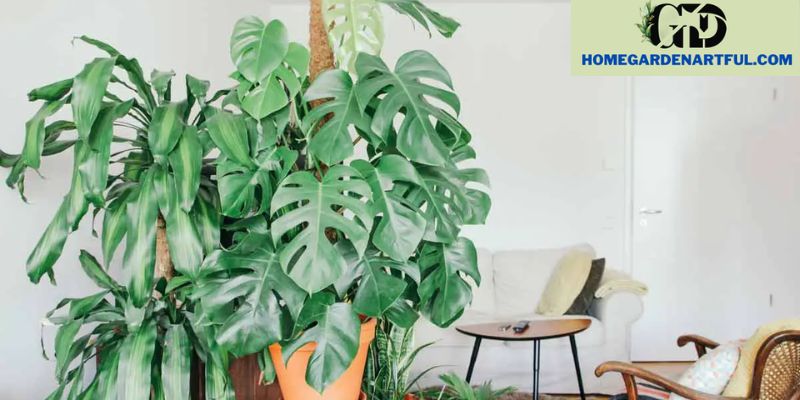Monstera Thai Constellation is a rare and visually striking houseplant prized by indoor gardeners for its gorgeous variegated leaves. The plant features irregular white splotches on deep green leaves that make each leaf look distinct and unique.
While the Monstera deliciosa is quite common, the Thai Constellation variety is still relatively new on the scene and is notoriously difficult to find in local plant stores. Luckily, Monstera Thai Constellation is gaining popularity and becoming more available thanks to its growing online following and demand from houseplant enthusiasts.
If you’re lucky enough to get your hands on a Monstera Thai Constellation, you’ll want to make sure you know how to properly care for it to keep it healthy and maintain its beautiful variegation over time. Read on for a complete care guide covering everything you need to know about successfully growing Monstera Thai Constellation at home.
Light Requirements

Monstera Thai Constellation needs moderately bright, indirect light to thrive. Direct sunlight can scorch the leaves, especially the delicate white parts which are more prone to burning.
A South or West facing window provides an ideal light situation in most homes. If the light is too intense, you can diffuse it by hanging a sheer curtain in the window. Rotate the plant periodically so all sides get even light exposure.
Low light will cause the leaves to grow smaller and lose their white variegation over time and turn completely green. Make sure to monitor your plant and adjust its location accordingly if the variegation starts fading.
Watering and Soil Needs
Monstera Thai Constellation prefers moist, but not wet or soggy soil. Water thoroughly when the top inch of soil is dry and make sure excess water can drain out the bottom of the pot. Allow the soil to partially dry out before watering again.
Use a well-draining potting mix with peat moss, perlite, bark chips or similar. You can also mix in some orchid bark to improve drainage. Avoid soil mixes that stay overly wet.
In the winter when growth slows, allow the soil to dry out a bit more between waterings. The biggest risk of overwatering is root rot, so water carefully and ensure the pot drains well.
Feeding and Fertilizer
Feed Monstera Thai Constellation monthly during the active growing season (spring through summer) with a balanced houseplant fertilizer diluted to half strength. Look for a fertilizer labeled for foliage plants or tropical varietes.
Any all-purpose diluted liquid fertilizer will do the job. You can also use a time-release pellet fertilizer mixed into the soil at planting time to provide nutrients continuously.
In the fall and winter, hold off on fertilizing when plant growth naturally slows down. Resume regular feeding when new growth appears in spring.
Temperature and Humidity
Monstera Thai Constellation thrives in average home temperatures between 65-80°F. Cooler temperatures below 60°F can sometimes impact leaf growth.
This tropical plant also appreciates decent humidity around 40-50%. Use a room humidifier nearby or place the pot on a pebble humidity tray to boost moisture in the air. Mist the leaves periodically as well.
Keep away from heat vents, fireplaces or other sources of drying heat which may damage the leaves. The white variegation is especially prone to browning and scorching when the air is too dry.
Supporting and Staking

As a vining plant, Monstera Thai Constellation will eventually need support from a moss stake, trellis or other climbing aid. This helps encourage upright growth.
Without support, the stems will start to trail downward once they reach a certain size. Add a sturdy stake or moss pole when repotting to support mature growth.
You can also prune back excessively long vines or aerial roots to keep your Monstera more compact if needed. But staking early on will help maintain its structure.
Repotting
Repot Monstera Thai Constellation each spring as new growth resumes. Move it to a pot one or two inches larger in diameter. This tropical plant prefers somewhat snug quarters and doesn’t need frequent upsizing.
Use pot with drainage holes and well-aerated potting mix amended with bark, perlite or coconut coir to enhance drainage. Keep the base of the stem intact and loosen the roots gently before repotting.
After repotting, allow a few weeks for recovery before resuming fertilizing. Repotting helps refresh the soil and provides room for new root growth.
Propagation
Propagating Monstera Thai Constellation allows you to create new plants for free! Take stem cuttings in the spring or summer using a section of vine with a few leaves and nodes.
Remove the lower leaves and place the cutting in water or moist potting mix. New roots will sprout within a few weeks and the cutting can be potted up to grow into a brand new plant.
Another option is air layering, where you encourage aerial roots to form before taking a cutting. This propagates mature plants successfully when stem cuttings fail.
Common Problems
Monstera Thai Constellation is prone to the same issues as other household Monstera plants, including:
- Leaf spotting from inconsistent watering
- Drooping or wilting leaves due to underwatering
- Root rot from overwatering
- Pest infestations like spider mites
- Leaf browning and scorch from too much direct light
Catch problems early and adjust care to resolve any cultural issues. Wipe leaves to remove dust buildup. Isolate plants with pests and treat accordingly.
Conclusion
With its stunning variegated foliage, Monstera Thai Constellation makes a fantastic (yet challenging to find) addition to any indoor plant collection. Follow these important care tips to successfully grow this eye-catching houseplant.
Give it bright filtered light, consistent watering, warm temperatures and humid conditions to allow your Monstera Thai Constellation to truly thrive and show off its unique colors.
Heading: Monstera thai constellation
Monstera thai constellation is a rare and beautiful variety of the monstera plant that is highly prized by indoor plant enthusiasts for its striking variegated foliage. Here is an overview of this exotic houseplant:
Origins – Monstera thai constellation originated as a mutation of the monstera deliciosa species in Thailand, hence its name. It was first discovered and stabilized into a variety by plant breeders in Thailand in the early 2000s.
Appearance – The leaves of monstera thai constellation have irregular white splotches and streaks on a background of deep green. No two leaves look exactly alike. The variegation occurs due to lack of chlorophyll in parts of the leaf tissue. In bright light, the white areas take on a silvery green or pinkish hue.
Growth habit – Like other monsteras, this variety has a vining growth pattern if unsupported, with large split leaves on long petioles emerging from the stem. It can reach up to 6 feet tall at maturity. Aerial roots appear as the plant ages.
Light requirements – Monstera thai constellation grows best in bright, indirect light. Too much sun can burn the delicate white leaf sections. Low light causes poorer variegation. South or west facing windows work well indoors.
Soil & watering – Well-draining potting mix amended with perlite, orchid bark or coconut coir. Allow soil to dry out some between waterings. Likes consistent moisture but not soggy conditions. Drought tolerant once established.
Propagation – Propagate from stem cuttings or by air layering of mature plants. Cuttings root readily in water or potting mix. Maintaining variegation in offspring can be challenging.
Pests & problems – Fairly pest and disease resistant but can be prone to spider mites, mealybugs. Leaf spotting and root rot due to overwatering. Leaf scorch from too much light.
Monstera thai constellation is slower growing than the standard monstera deliciosa but is highly desirable for its stunning foliage. With the right care it makes a spectacular (yet expensive) houseplant specimen.


